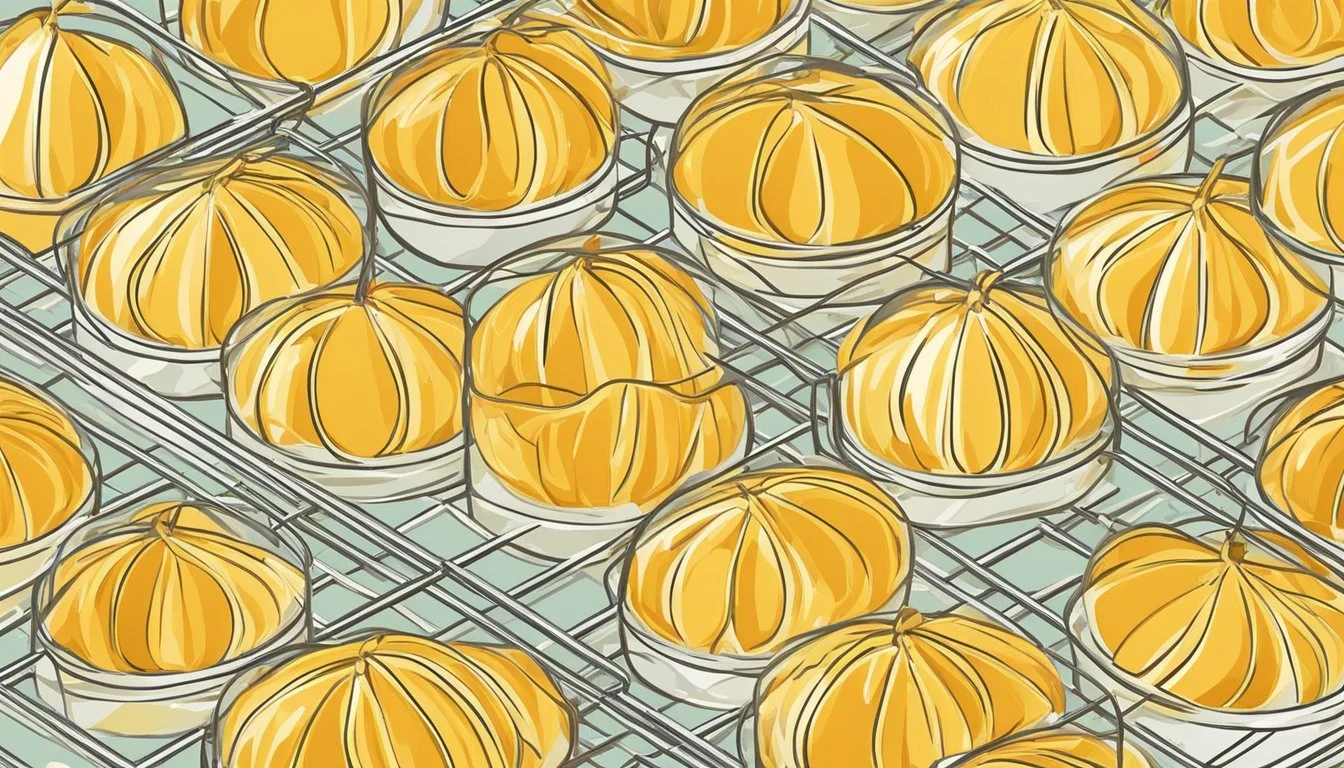Citrus Peel Candy
A Sweet, Chewy Treat Reinvented
Citrus peel candy, a confectionary delight enjoyed by many, transforms the often-discarded rind of citrus fruits into a sweet and chewy treat. This clever use of peel reveals the inherent versatility of citrus fruits beyond their juicy interior. By preserving the peels in a sugar syrup, they are given a second life as a decadent candy. The process involves boiling the peels to soften their tough exterior and reduce bitterness, then simmering them in a sweet syrup until they become tender and translucent.
The resulting candy strikes a balance between the tangy zest of citrus and the comforting sweetness of sugar, creating a treat that appeals to those who appreciate complex flavors. Whether made from oranges, lemons, or any citrus variant, the peels become irresistibly chewy once candied, offering a texture that is both satisfying to bite into and a joy to savor. It's a candy that stands out amidst a sea of chocolate and gummy treats, offering a refreshingly different kind of indulgence.
Traditionally, this candy has been enjoyed around the world and is particularly popular during festive seasons when citrus fruits are abundant. Even after being candied, the peels retain some of their vitamins and fiber, making them a relatively healthier option for those looking to satisfy their sweet tooth. Alongside their delightful taste, citrus peel candies serve as a testament to the creativity of confectioners who turn something simple into a gourmet experience.
History of Candied Citrus Peels
The tradition of candying citrus peels has roots that intertwine with the history of trade, confectionery, and preservation techniques. Originating from the Middle Ages, when fresh fruit was less accessible and sugar was an expensive commodity, candying fruit peels was a method to prevent spoilage and make use of the entire fruit.
Citrus fruits, such as oranges, lemons, and citrons, were treasured for their sweet fragrance and were a luxury in Europe, brought from the Orient and the Mediterranean via trade routes. Households looking to minimize waste and maximize luxury began to preserve the peels of these fruits by boiling them in sugar syrup.
Function: Initially, the candying process served a dual purpose—preserving the fruit peels for off-season enjoyment, and transforming them into a sweet treat that could be savored as a dessert or a snack.
Cultural Significance: Over time, candied citrus peels became embedded in culinary traditions across Europe and later, the Americas. They were used in an array of holiday desserts and fruitcakes, symbolizing a taste of sunshine during the winter months.
In terms of culinary evolution, candied peels graced pastries and desserts of the Renaissance banquets, showcasing the expertise of chefs who could turn something simple into a delicacy. Even as sugar became more affordable, the popularity of candied citrus continued to flourish due to its unique texture and richness in flavor.
The process reflects a history of ingenuity and taste that has carried candied citrus peels through centuries, maintaining their status as a beloved confection. With advancements in preservation and the global availability of fruits, the charm of candied peels remains, reminding us of the artful preservation from times past.
Benefits of Citrus Peel Candy
Citrus peel candy turns often-discarded fruit peels into a delightful dessert that not only brings joy to the taste buds but also offers a valuable addition to a diet.
Nutritional Value
Citrus peel candy, though coated in sugar, retains the nutritional benefits of the fruit from which it is derived. The peels are rich in fiber, which aids in digestion and can contribute to heart health. Additionally, they contain significant amounts of vitamin C, an antioxidant important for the immune system, skin health, and collagen production. Essential minerals like calcium and potassium are also present in the peels. These minerals are crucial for bone health and maintaining normal heart function and blood pressure levels.
Nutritional Components in Citrus Peel:
Fiber: Supports digestive health
Vitamin C: Essential for immune function and skin health
Calcium: Important for bone strength
Potassium: Helps regulate heart function and blood pressure
Culinary Uses
Citrus peel candy is versatile in the culinary world and can be enjoyed as a standalone snack or used as a garnish. It can enhance the flavor profile of various dishes, adding a sweet and tangy dimension to desserts like cakes, pastries, and puddings. As a decorative element, it contributes an aesthetic appeal to dishes, often used to add a pop of color and texture. The candying process, which involves sugaring and drying the citrus peels, extends their shelf life, making them a convenient ingredient to have on hand for culinary experimentation.
Ways to Incorporate Citrus Peel Candy:
As a snack: Enjoyed on its own for a chewy treat
In desserts: Adds a unique flavor and texture to baked goods
As a garnish: Provides an attractive finish to sweet dishes
Selecting the Right Citrus Fruits
The success of candied citrus peel hinges upon starting with high-quality fruit. The ideal candidates are fresh, organically grown, and free from blemishes to ensure the best flavor and texture in the final treat.
Identifying Fresh Fruit
Freshness is paramount when selecting fruit for candying. Fruit should feel firm to the touch, a sign of its juiciness and freshness. The skin should be vibrant in color and free of any soft spots, mold, or heavy bruising which can indicate decay. For citrus fruits like oranges and grapefruits, the heavier they are, the more juice they contain, which is a good sign of freshness. With lemons and limes, a glossy, fine-grained texture on the skin suggests a thinner rind, which is ideal for achieving a delicious candied peel.
Types of Citrus for Candying
When choosing types of citrus, one can select from a variety, with each providing its own unique flavor:
Oranges: Sweeter peels, often Valencia or Navel varieties.
Lemons: Thinner-skinned, Eureka or Lisbon types are commonly used.
Grapefruit: Larger with a bitter edge, giving a robust taste.
Lime: Tahiti or Persian limes are typically less bitter than Key limes.
Tangerines: Have thin peels and a sweeter, more nuanced flavor.
Choosing organic fruits is wise because they're free from pesticides and synthetic fertilizers, leading to peels that are safer for consumption. Organic fruits often possess stronger natural flavors that are beneficial when making candied peels.
Preparation Techniques
The preparation of citrus peel candy involves meticulous cleaning and peeling of fresh citrus fruits followed by careful removal of the bitter pith. Proper technique ensures that the final product has the perfect balance of sweetness and texture.
Cleaning and Peeling
One begins by thoroughly washing the citrus fruits under running water to eliminate any dirt or residues. It's crucial to use a vegetable peeler or a sharp paring knife to peel off the skin. These tools help achieve long strips while minimizing the capture of the bitter white pith underneath.
Tools Needed:
Vegetable peeler
Paring knife
Steps:
Wash the citrus fruit thoroughly.
With a peeler or knife, carefully remove the skin in long strips.
Removing the Pith
After peeling, the next step is detaching any remaining white pith from the peel as it contributes a bitter flavor that's undesirable in the candy.
Method:
Lay peel flat.
Gently scrape off the pith, leaving the vibrant colored zest intact.
Considerations:
The pith should be removed without damaging the zest.
Preservation of the zest's integrity is key for proper candying.
Candying Process Step-by-Step
In creating candied citrus peels, one follows a meticulous process to transform the bitter peel into a sweet, chewy treat. The method involves making a simple sugar syrup, boiling the peels to remove bitterness, and then simmering them in the syrup for infusion of sweetness.
Preparing the Syrup
To prepare the syrup, combine 2 cups of sugar with 1 cup of water in a medium saucepan. Place the saucepan over medium heat and stir until the sugar fully dissolves. This process creates a simple syrup that infuses sweetness into the peels during the later simmering stage.
Boiling the Citrus Peels
First, the citrus peels are thoroughly washed. They are then cut into strips, aiming to leave behind as much of the bitter white pith as possible. The prepared strips are added to a saucepan filled with water and brought to a boil. This initial boil lasts for about 5 minutes. The peels are drained and the boiling step is repeated two more times with fresh water each time to further reduce bitterness.
Simmering and Soaking
After the third boil, the citrus peels are placed back into the saucepan with the prepared sugar syrup. The mixture is brought to a simmer over medium heat, not a rolling boil, to ensure the peels retain their shape and texture. The peels simmer for about 15 minutes until they become translucent. They are then removed from the heat and allowed to soak in the syrup, which can extend from several hours to overnight, to fully absorb the sweetness.
Drying and Storing
Proper drying and storage of candied citrus peels ensure they retain their sweet flavor and chewy texture. Below are methods and solutions for the most efficient drying and storage processes.
Air-Drying Methods
Air-drying the candied citrus peels is vital for achieving the perfect chewiness. Once coated in sugar, the peels should be laid out in a single layer on a parchment-lined drying rack or wire rack to allow air to circulate freely around them. This setup should be placed in a cool, dry area and away from direct sunlight. The drying process usually takes about 24 hours, but this can vary depending on humidity and temperature. The peels should feel firm to the touch and should no longer be sticky once they are properly dried.
Storage Solutions
Once dried, candied citrus peels should be stored in an airtight container to maintain their texture and prevent them from becoming stale. Containers should be kept at room temperature in a dark, cool place for short-term storage. For long-term storage, candied peels can be refrigerated or frozen. If choosing to refrigerate, the airtight container will prevent the peels from absorbing other flavors. To freeze the peels, one should ensure that they are wrapped tightly in plastic wrap and then placed inside a container before putting them in the freezer. When one wants to use them, the peels should be thawed at room temperature.
Adding Flavors and Textures
Crafting candied citrus peels opens a world of possibilities for flavors and textures. Meticulous coating and pairing with complementary ingredients can transform the simple candy into a gourmet experience.
Coating Options
Chocolate: Dipping the candied peels in melted chocolate adds a rich layer that contrasts the citrus' tartness.
Milk Chocolate: Creamy and sweet. Works well with the inherent bitterness of the peel.
Dark Chocolate: Offers a strong cocoa flavor with less sweetness, complementing the citrus zing.
Sugar Coatings:
Granulated Sugar: Provides a classic, crunchy texture.
Powdered Sugar: Gives a soft, velvety finish and a subtle sweetness.
Using chocolate coatings can also infuse additional flavors, such as vanilla, to complement the citrus tones.
Pairing with Other Ingredients
Vanilla: Infusing the syrup with vanilla beans during the candying process introduces a warm, aromatic quality.
Salt: A light sprinkle of salt after coating can balance sweetness and highlight the citrus profile.
Pairing the peels with nuts or dried fruits (What wine goes well with dried fruits?) can create an interesting texture contrast and flavor combination, especially when the peels are coated in chocolate or sugar which can ease the transition between the differing tastes.
Creative Uses in Recipes
Candied citrus peels are versatile ingredients that can elevate various recipes from ordinary to extraordinary with their unique sweet and tangy flavor profile.
Baking
In baking, candied citrus peels add a delightful chewy texture and a burst of flavor to cakes and cookies. Incorporating finely chopped peel into batter or dough imparts a subtle citrus essence that pairs exceptionally well with spices and vanilla.
Cakes: Fold them into cake batters for a zesty twist, or adorn the tops for a decorative and flavorful finish.
Cookies: Mix into cookie dough for orange or lemon-flecked treats that carry a mellow citrus tang. They blend well with chocolate chips or dried fruits.
Garnishing
Candied peels serve as an elegant garnish, adding both visual appeal and a touch of sophistication to desserts and drinks. Their versatility also makes them an ideal component for sprucing up savory dishes like salads.
Desserts: Sprinkle over ice cream or incorporate into chocolate bark, enhancing desserts with their vibrant color and zesty flavor.
Cocktails: Use them as a stirrer or rim decoration, giving an attractive look and a flavor boost to cocktails.
Salad: Incorporate into salad dressings for a sweet and citrusy note or sprinkle on top as a candied accent to a fresh salad.
Tips and Tricks for Perfection
When making candied citrus peel, the end goal is to achieve a balance in texture and appearance. The right level of chewiness and a glossy, translucent look are indicators of a well-made candy.
Achieving the Ideal Chewiness
To ensure the citrus peels become soft and chewy, they must be boiled properly. The initial step involves boiling the peels in water for 5 minutes and repeating this process at least twice to remove bitterness. Afterward, the peels need to be cooked in a sugar syrup. It’s important to maintain a medium-high heat and let them simmer gently until they absorb the sweetness and become soft. The texture should be yielding, not mushy.
Boil the peels three times for 5 minutes each to remove bitterness.
Simmer in sugar syrup on medium-high heat until peels are soft.
Ensuring Translucency
Translucency in candied citrus peels is a sign they have been candied correctly. To achieve this, one must cook the peels in the sugar syrup until the syrup reduces and the peels turn see-through. The mixture should be kept at a consistent boil, ensuring that the temperature reaches approximately 230-235°F. Stirring occasionally helps in evenly distributing the heat and prevents the peels from sticking to the bottom.
Boil in sugar syrup until peels are translucent and syrup thickens.
Keep the syrup at a moderate, consistent boil and use a thermometer to check temperature.
By following these steps carefully, the candied citrus peels will turn out delightfully chewy with a beautiful translucent sheen.
Nutrition Facts and Health Considerations
Citrus peel candy, often enjoyed for its sweet and tangy flavor, packs a nutritional punch with beneficial vitamins and minerals. However, it is also important to consider its caloric and sugar content in a balanced diet.
Caloric Content
Citrus peel candies are relatively low in calories. A single piece typically contains between 20 to 30 calories, depending on the size and additional ingredients used. Since these treats are often consumed in moderation, they contribute minimally to the overall daily caloric intake.
Sugar and Dietary Concerns
The main dietary concern in citrus peel candy is the sugar content. In the candying process, peels are coated or infused with a sugar syrup, significantly increasing their sugar content. Consuming high amounts of added sugars can lead to health issues, such as weight gain or increased risk for dental decay.
Sugar: A typical serving can have upwards of 10 grams of sugar. This is a considerable amount, especially for individuals monitoring their sugar intake.
Fiber: The candied fruit retains some of the natural fiber found in the peels, beneficial for digestive health.
Sodium: Citrus peels are naturally low in sodium, making them a suitable treat for those on a sodium-restricted diet.
Protein: There is minimal protein in citrus peel candies, as they are primarily composed of sugars and carbohydrates.
Individuals with dietary restrictions or those managing blood sugar levels should consume citrus peel candy in moderation and remain mindful of their overall daily sugar consumption.
Packaging and Presentation
The presentation of Citrus Peel Candy can elevate the simple treat to a cherished indulgence or an attractive gift. One should consider factors like container choice and the method of wrapping to both preserve freshness and convey a sense of occasion.
For Personal Consumption
For those preparing Citrus Peel Candy for personal enjoyment, keeping the candy fresh is key. The individual should opt for an airtight container to maintain chewiness and prevent hardening. Lining the container with parchment paper can prevent sticking and clumping, especially if the candies are sugared. One might consider dividing the candy into servings, which can make it easier to enjoy in moderation.
Container: Airtight container
Wrapper: Parchment paper
Servings: Pre-divided based on personal preference
For Gifting or Sale
When packaging Citrus Peel Candy for gifts or sale, aesthetics are as important as preserving the candy’s quality. Select a container that reflects the joy and vibrancy of the candy within—a clear jar or a decorative box with a window can be quite appealing. During holidays like Christmas, thematic embellishments can add to the festive spirit. Including information on total time and prep time on the label can inform recipients of the care put into the homemade treat.
Container: Clear jars, decorative boxes, cellophane bags
Presentation: Tied with a ribbon, thematic embellishments
Information: Label with total time and prep time
Variations and Regional Differences
Candied citrus peel is a treat enjoyed around the world, with each region putting its signature twist on this classic sweet. Traditional recipes and local citrus varieties give each version its unique flavor and texture.
International Varieties
In Italy, candied citrus peel is known as arancia candita for orange, and cedro candito for citron. These are often found in panettone and cassata cakes. Italy also features candied lemon peel (limone candita), which is a key ingredient in limoncello.
France has its orangettes, which are strips of candied orange peel dipped in dark chocolate, marrying the bitterness of the orange with the richness of the chocolate.
Spain features cáscara de naranja confitada, where Seville oranges, known for their bitter taste, are commonly used to create a more intense flavor.
Local Specialties
Across the United States, candied orange and lemon peels are popular during the holiday season, often used as ingredients in fruitcakes and other confections. In the southern states, one may find candied grapefruit peel, taking advantage of the local citrus bounty.
In Mexico, candied lime peels or acitrón from the biznaga cactus, simulating the texture of candied citrus, are incorporated in many traditional sweets and are a staple during the Day of the Dead festivities.
The Caribbean islands utilize the abundance of local limes to make candied lime peel, which is savored as a standalone treat or used in baking.
By understanding these regional variations, one appreciates the diversity and cultural significance that candied citrus peels represent worldwide.
Discussion and User Comments
In this section, we delve into the perspectives and inquiries of individuals who have tried their hand at making citrus peel candy. Their insights provide valuable feedback for both novice and seasoned candy makers.
User Feedback
Users have shared their experiences, offering both praise and constructive criticism. Below is a summary of their comments:
Sweetness Level: Many users find the sweetness of citrus peel candy to be just right, appreciating how the sugar compliments the natural tanginess of the citrus.
Texture: The chewiness of the candy is generally well-received; however, some have suggested boiling the peels a bit longer for a softer texture.
Variety of Uses: Enthusiasts of citrus peel candy often mention its versatility, using it in baking or simply as standalone snacks.
Difficulty Level: Feedback indicates that the process is straightforward, with first-timers finding success in following the steps.
Q&A Section
Questions commonly asked by users, accompanied by expert responses:
How do I prevent the candy from being too bitter?
Reduce bitterness by boiling the peels several times before adding sugar.
Can I use different types of citrus?
Yes, oranges, lemons, grapefruits, and even limes can be used to make citrus peel candy.
How long does citrus peel candy last?
When stored in an airtight container, the candy can last up to several weeks.
Is it necessary to use a sugar thermometer?
While not essential, a sugar thermometer can help in reaching the perfect syrup consistency.
Conclusion
Citrus peel candy, with its perfect blend of sweetness and tang, is a testament to the simple pleasures of homemade confections. These sugary strips are not only a delicious way to repurpose citrus peels, but also a reflection of resourcefulness in the kitchen.
They typically require only a handful of ingredients:
Citrus peels: orange, lemon, lime, or grapefruit
Sugar
Water
The process of transforming the peels from bitter to sweet involves several steps of boiling to remove bitterness, followed by simmering in a sugar syrup to infuse sweetness and achieve a chewy texture. The result is a candy that is both a treat and a celebration of simplicity in creation.
Citrus peel candy can bring joy in various ways:
As a snack: eaten on its own for a burst of citrus flavor.
As a garnish: added to desserts for an elegant touch.
As a gift: packaged beautifully to share the sweetness with friends and family.
In making citrus peel candy, one exercises culinary creativity while giving a nod to traditional methods. This candy reaffirms that the best treats often arise from a confident application of simple techniques to everyday ingredients.








